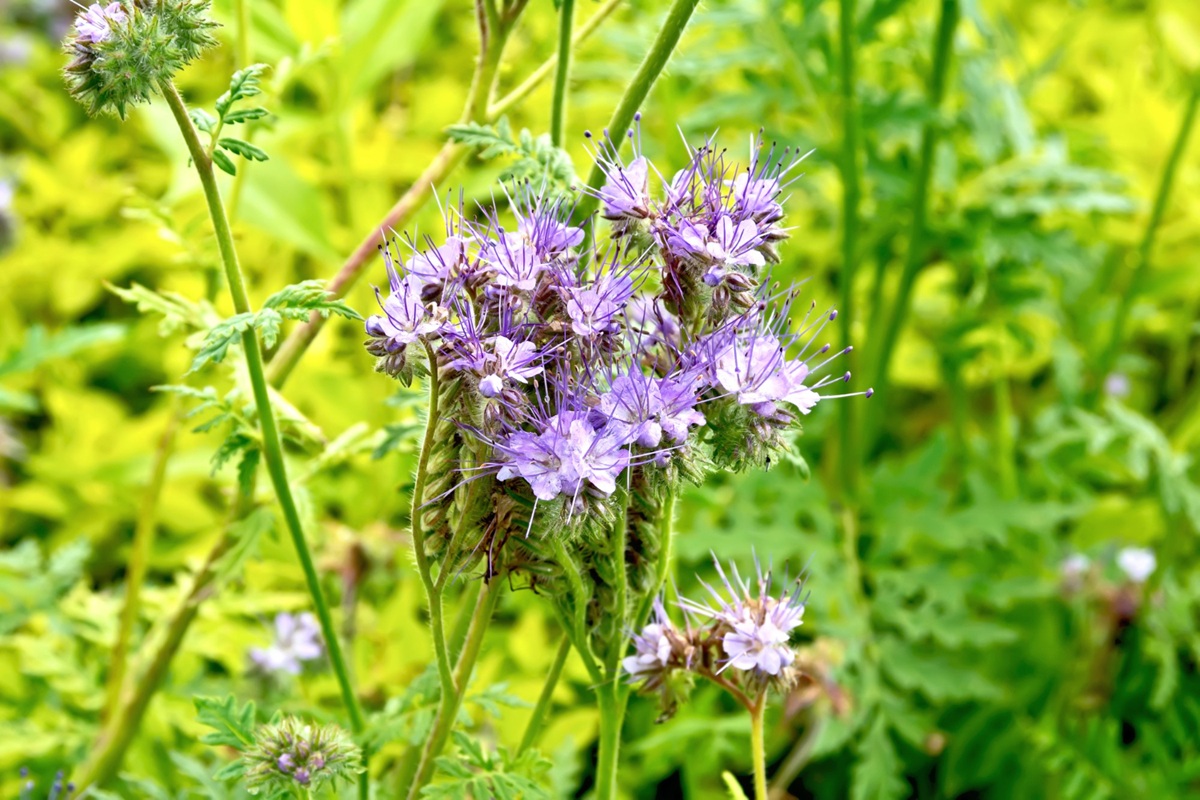Are you tired of spending your weekends mowing the lawn? Do you dream of a garden that is beautiful, eco-friendly, and requires little upkeep? Consider planting phacelia. This charming plant with violet flowers offers a surprising alternative to traditional lawns, attracting an increasing number of gardeners who are mindful of ecology and time-saving solutions.
Discovering Phacelia: A Complete Overview of This Amazing Plant
Scientifically known as Phacelia tanacetifolia, phacelia originates from North America. This annual plant from the Hydrophyllaceae family boasts impressive growth, reaching heights of 30 to 80 cm.
Its delicately cut leaves resemble those of ferns, while its blue-violet flowers form beautifully curled clusters.
Another advantage? It adapts effortlessly to various exposures, from full sun to partial shade, as well as to different types of soils, even poor ones. It also tolerates cold temperatures down to -5°C.
@rustica_jardinPhacelia: A Valuable Ally for Your Garden 🌸 Easy to grow, phacelia is not only stunning with its violet flowers but also excellent for enriching the soil and attracting pollinators. 🐝 Additionally, it serves as an ideal green fertilizer, promoting biodiversity and the health of your garden. 🌿 #Gardening #Phacelia #GreenFertilizer #Pollinators
Why Choose Phacelia Over Traditional Lawns?
Have you ever calculated how much time and resources your traditional lawn actually requires? In contrast, phacelia demands minimal maintenance while delivering an impressive visual impact:
- No mowing required: Say goodbye to Sunday chores—phacelia naturally maintains its ideal height.
- Significant reduction in water needs: Save up to 70% compared to a traditional lawn.
- Natural soil fertilization: Its roots improve soil structure and fix nitrogen.
- Self-seeding under favorable conditions: It spreads easily from year to year.
This leads to better time management and significant savings on natural resources.
The Undeniable Ecological Benefits of Phacelia
Phacelia is not just visually appealing; it is also environmentally beneficial.
- Exceptional nectar source: It attracts pollinators like bees, ensuring biodiversity.
- Effective erosion protection: Its dense roots stabilize the soil, particularly on sloped terrains.
- Natural repellent effect against certain pests: This helps limit the proliferation of weeds and underground pests.
Did you know that a single square meter of phacelia can nourish up to 300 bees per day? Food for thought…
How to Replace Your Lawn with a Beautiful Cover of Phacelia?
It’s straightforward, with a few steps to make your life easier:
Prepare Your Soil Well: An Essential Step!
For a successful planting, prepare your area by following these guidelines:
- Mow the old lawn very short.
- Carefully remove all persistent weeds.
- Till and level the surface thoroughly.
Sowing: The Right Timing to Respect
Choose your sowing period based on your desired flowering:
- Spring (March-May) for summer blooming.
- Summer (June-August) for extended colors into autumn.
- Autumn (September-October) for soil protection over winter and early spring blooming.
A dosage of 10 to 12 grams of seeds per square meter is sufficient, to be scattered at a depth of no more than one centimeter.
Simplify Maintenance After Sowing
Once the phacelia is established, you can forget about regular watering and weeding. A light intervention is all that is needed for specific issues. To maintain lasting results, consider staggered sowing or combining with perennial plants.
What Plants to Ideally Combine with Phacelia?
Create a Beautiful Flowering Meadow with Wildflowers
Phacelia pairs wonderfully with:
- Poppies: for a stunning touch of red color.
- Cornflowers: a perfect blue complement.
- Corncockle and marigolds: to harmonize and brighten the mixture with light and vibrant hues.
Enhance the Green Fertilizer Effect by Combining with Other Beneficial Plants
Here are some other beneficial companions:
- White mustard: for a fast, complementary root cover.
- Clover: ideal for fixing more nitrogen and adding color.
- Vetch and buckwheat: great for enriching the soil and attracting beneficial insects.
Your Frequently Asked Questions: Let’s Clarify
- Does phacelia tolerate foot traffic? Yes, but moderately. Plan for pathways or combine it with clover in heavily trafficked areas.
- Do I need to sow it every year? Officially, yes. But if you let it seed, it often reseeds itself.
- Does it increase the risk of harmful insects? Not at all! On the contrary, it attracts beneficial insects.
- Is it adaptable throughout France? Absolutely, as long as you follow the sowing periods according to the local climate.
Now you know everything about what could make you the ecological hero of your neighborhood!
Does this alternative to traditional lawns inspire you? Would you be willing to adopt phacelia in your garden? Share your thoughts and experiences in the comments below; we are curious to hear your reactions! Feel free to ask your questions; we will be happy to respond.
I’m a disabled, xennial Christ-follower, slightly off kilter (but aren’t all “ar-teeests”?).
Hope you enjoy my rantings, don’t take my sarcasm too seriously and know that comments are welcome. 🙂


Leave a Reply